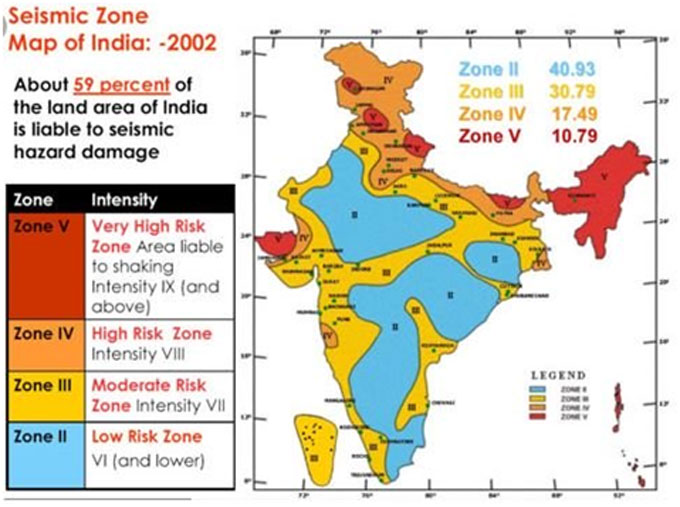
Seismic Zones in India

In the field of seismology, seismic zones are, areas divided based on the frequency and intensity of expected earthquake. Indian subcontinent comprises of four seismic zones those are- II, III, IV and V. These zones are categorized based on scientific research related to seismicity and earthquake occurrence in the past years.
Earlier India was divided into five zones, but then, The Bureau of Indian Standards [IS 1893 (Part I):2002] decided to group the country into four seismic zones, where, the first and second zone being unified.
The Bureau of Indian Standards is responsible for publishing seismic activities in terms of seismic hazard maps and codes. They brought out a total of three versions of seismic zones; a six zone map in 1962, a seven zone map in 1966 and a five zone map in 1970/1984.
Seismic Active Zone:
Seismic Zone II: This is the area that suffers least damage of the other three zones. Intensity of earthquake lies between intensities V to VI of MM scale (MM ? Modified Mercalli Intensity scale).
Zone II covers those areas which are not covered by the other zones listed below.
Seismic Zone III: Zone III receives moderate damage. This damage corresponds to intensity VII of MM scale.
States that lie under this zone are- Tamil Nadu, Orissa, Andhra Pradesh, Maharashtra, Chhattisgarh, Bihar, Jharkhand, Bihar, Madhya Pradesh, Kerala, Gujarat, Goa, Lakshadweep islands, West Bengal, Karnataka, parts of Punjab and some remaining parts of Uttar Pradesh.
Seismic Zone IV: Seismic Zone IV receives major damage having intensity VII and higher of MM scale. It covers remaining parts of Jammu and Kashmir and Himachal Pradesh, Delhi, Sikkim, Northern parts of Uttar Pradesh, Bihar and West Bengal, parts of Gujarat and small portions of Maharashtra near west coast and Rajasthan.
Seismic Zone V: Zone V is the most active region of the three. Historically this region has faced some of most devastating earthquakes. Magnitude here exceeds 7.0 and had intensities higher than IX. It comprises part of North Bihar, Andaman and Nicobar Islands, Rann of Kutch in Gujarat, parts of Jammu and Kashmir, Uttaranchal and entire northeastern India.
Seismic Zones with intensity in Indian Subcontinent of the Map
Richter scale: Earthquakes are measured using an instrument called seismograph. It records a zigzag trace that reflects the varying amplitude of the ground oscillation beneath the instrument. Earthquakes with magnitude of about 2.0 or less are generally not felt by people. A 5.3 magnitude earthquake is considered moderate and, a strong one will be 6.3 or above. The logarithm of amplitude of waves gives the magnitude of the earthquake. Magnitude of the earthquake is measured in whole numbers and decimal fraction on the Richter scale.


